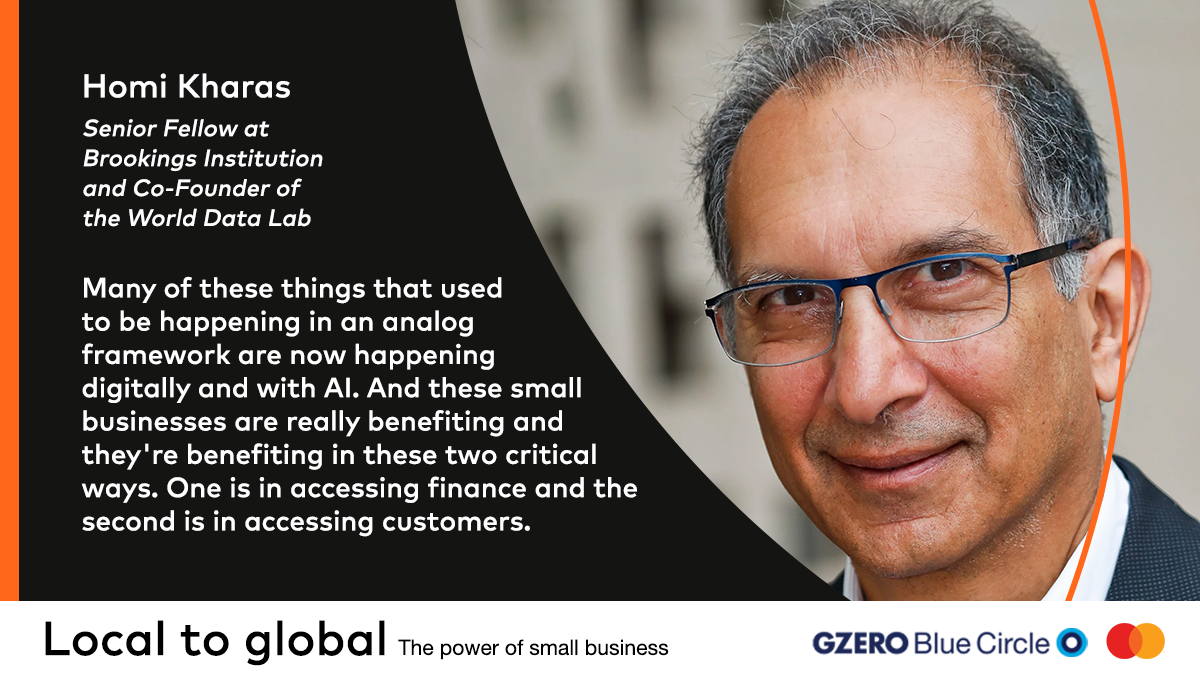
Local to Global: Why Small Businesses Are the Hidden Engine of the Global Economy
When we think of small businesses, we often think local, a favorite corner store, a trusted tradesperson, or the indie café that knows your order by heart. But the story of small business is not just one of community. It’s a global force.
In fact, small and medium-sized enterprises (SMEs) make up 90% of businesses worldwide and contribute nearly half of global GDP. While large corporations grab the headlines, it's small businesses that quietly power economies, fuel job growth, and now, thanks to technology, stand at the forefront of global innovation.
In the latest episode of Local to Global: The Power of Small Business, JJ Ramberg spoke with Shamina Singh, President of the Mastercard Center for Inclusive Growth, and Homi Kharas, Chief Economist at World Data Lab and Senior Fellow at Brookings, to unpack why small businesses matter now more than ever.
Small Business: Backbone and Brain of Global Economies
Small businesses don’t just support economies, they are economies, especially in developing countries. “In many emerging markets, small businesses are not only the backbone, they’re the heart, lungs, and brain of the economy,” says Kharas. In these regions, SMEs are the primary source of jobs and income, from retail trades and local transport to manufacturing and services.
Shamina Singh adds that small businesses are often the first to create jobs, drive innovation, and stimulate capital in their communities. “It's hard to imagine trade, commerce, or even daily life, without small businesses at the core.”
The Global Middle Class is Booming and Small Businesses Will Serve It
One of the most transformative trends today is the rise of the global middle class. For the first time in history, over half the world’s population falls into this category, approximately 4 billion people.
In emerging markets, 110 million people are joining the middle class every year. While middle-class growth in advanced economies is stalling or bifurcating, developing economies, particularly in Asia and Africa, are seeing rapid expansion. These newly empowered consumers are creating unprecedented demand, and small businesses are stepping in to meet it.
Singh underscores that this isn’t the traditional “two-car garage” middle class. “This is someone moving from $4 to $15 a day, people opening bank accounts, gaining access to credit, and increasing their purchasing power in meaningful ways.”
Women, Gen Z, and the Rise of the “Strivver”
Women and young people are increasingly driving global entrepreneurship. Mastercard’s research reveals that:
- 78% of women in Eastern Europe, the Middle East, and Africa aspire to own a business.
- 89% of Gen Z women globally want to become entrepreneurs.
- 55% of women already operate side hustles, yet 35% report being targeted by fraud.
Singh introduces a term Strivvers to describe business owners who’ve outgrown micro-financing or personal credit cards but aren’t yet eligible for traditional loans. This “missing middle” represents one of the most dynamic, yet underserved, segments of global entrepreneurship.
Digital Tools Are Opening Doors, But Training Is Key
Digitalization is reshaping how businesses are launched and scaled. According to Mastercard’s 2024 SpendingPulse, online retail grew 6.7% year-over-year, more than double the growth of in-store retail.
But many small businesses still struggle to go digital. The good news? Cities like Tampa and Phoenix are leading the way with double-digit growth in small business creation, thanks to digital tools.
However, Singh notes that tech can feel overwhelming to newcomers. “Strive,” Mastercard’s initiative, along with platforms like Digital Boost, are helping entrepreneurs cut through the noise and use tools like AI and SEO effectively to grow their business.
AI and Financial Inclusion Are Changing the Game
Homi Kharas notes that even farmers in remote areas are now benefiting from AI—often without realizing it. From accessing credit based on digital payments to using farm-to-market platforms, AI and digital tools are enabling financial inclusion and broader market access.
But Singh adds a critical reminder: cybersecurity must come first. Nearly half of surveyed SMEs have experienced a cyberattack. Of those, one in five closed their doors afterward. “Cybersecurity must be priority number one, not an afterthought,” she warns.
To support this, Mastercard is developing and translating low-cost cybersecurity toolkits, including for high-growth regions like Indonesia.
Community and Mentorship: The Soft Infrastructure of Success
Small business can be a lonely path, but it doesn’t have to be. Singh emphasizes that building networks of peer-to-peer support, mentorship, and shared learning can help small businesses thrive together.
One standout story: Dalia Shaw, the founder of Sparkle Lighting, doubled her business after connecting with Digital Boost mentors who helped her navigate SEO, inventory tracking, and digital marketing. “Simple, smart interventions can have outsized impact,” Singh says.
The Future Is Bright, and Inclusive
As the conversation wrapped, both guests offered closing thoughts:
“We’re entering a new era,” says Kharas. “Where barriers to small business success are falling away, and inclusion—especially for women and youth—is finally being prioritized.”
Singh adds, “If you’re a consumer, buy from local small businesses. If you’re in the private sector, help them go digital. If you’re a small business owner—know this: when you win, the world wins.”
Listen to the full Podcast HERE


